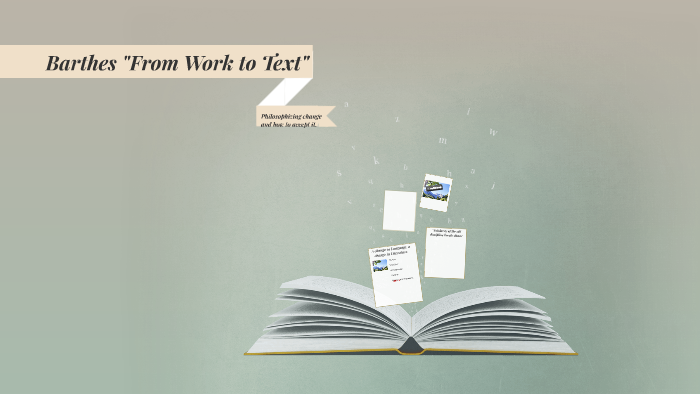Roland Barthes can be considered both a structuralist in his early phase and a post-structuralist in his later phase. The works such as "Elements of Semiology and Mythologies", and "The Fashion System" belong to structuralism where as "The Pleasure of the Text", "Change the Object Itself" and "From Work to Text", come under post-structuralism. As a structuralist he is concerned with the human world and tries to uncover it through detailed observational analysis and as a post-structuralist he is concerned with the philosophical position of the work and began to explore a far reaching possibilities of a work of art. He draws our attention to the fact that concept of language has undergone a sea change over the years.
|
WORK |
TEXT |
|
Ø Limited meaning |
Different layers of meaning |
|
Ø Monistic approach |
Multiple approach |
|
Ø Closed entity |
Methodological/ open, wide implication |
|
Ø Relevant in structuralism |
Poststructuralism |
|
Ø Only has signified |
Signifiers |
|
Ø Moderately symbolic |
Radically symbolic |
|
Ø Fixity of meaning |
Multiplicity |
|
Ø Readerly |
Writerly |
In the essay, "From Work to Text" Barthes states his position clearly and emphatically in the light of structuralist and post-structuralist approach to language and meaning. The approach to literature studies has become interdisciplinary. Interdisciplinary approach to criticism necessarily involves not only two disciplines but it offers endless possibilities for Interpretation. This approach gives rise to the study of intertextuality -a term employed by both structuralists and post-structuralists.
In this approach to criticism, a text is regarded as a 'stratified' structure (in layers) containing echoes and references to other texts. Here, the critic is expected to respond to the intertextual potential of a text in taking out its parts layer by layer. Instead of the monistic approach adopted by the New critics, Barthes wants to make a combined approach such as Marxism, Freudianism and Structuralism and so on to the study of literature.
Having said this, Barthes comes to the central point of his essay, he explains the fundamental opposition between Work and Text. he states that there cannot be "a material separation of works and texts." The difference is that "the work is concrete, occupying a portion of book-space (in a library, for example – it’s a closed entity like religious books as it conveys limited sense ), the Text, on the other hand, is a methodological field (more purpose, actively used by readers in general and scholars in particular)." The work can be seen in several places such as book stores, card catalogues and on course lists . Barthes notes that:
It is difficult to describe the Text for it defies the classification on the basis of genre. A poet, a novelist, an essayist and even an economist all are said to have written 'texts.' In the words of Barthes, "The Text is that which goes to the limit of the rules of enunciation (rationality, readability and so on)" (415).
If we take each linguistic unit as a sign, then the "work" itself functions as a general sign. A sign consists of a signifier (sound image) and a signified (the concept). The field of the Text' is that of the signifier and the 'work' closes itself on a signified. Barthes brings out the difference between the 'work' and the Text' in relation to language: "The work (in the best of cases) is moderately symbolic (its symbolism has certain limitations), but the Text is radically symbolic.
Etymologically the text is a cloth, and 'textus' from which the text derives, means 'woven’ (different colourful things can be made). Like all structuralists and post structuralists Barthes believes in multiple meaning or polysemy of interpretation. Hence the 'Text' does not have fixity of meaning. On the other hand, it has potentiality for meaning. Barthes like other post-structuaralists directs his attention primarily to how a piece of literature exemplifies the language system. In other words, he treats literature as 'Text.' It is in this sense he says that the 'Text' is plural. The 'Text' yields to plurality of meaning.
Barthes rightly acknowledges that each 'text' is an inter text' of another 'text' but at the same time maintains that the originality of the 'text' should not be missed upon the readers. It is the plurality of the 'text' that distinguishes it from 'work.' In the words of Barthes:
The Text, on the other hand, is read without the father's signature. The metaphor that describes the Text is also distinct from that describing the work. In another essay, "The Death of the Author," Barthes denies the author and banishes it from the text.
The 'text' is said to act upon the reader and makes him reproduce the 'text' in the process. This is a great innovation. He is of the opinion that while the work gives the reader pleasure and Enlightenment, where as the 'text' gives him enjoyment (jouissance). What he tries to suggest is that while the reader or the critic reads a 'work,' he derives pleasure out of it but very rarely he creates the 'work' himself. On the other hand while reading the 'text' the reader or the critic re-creates the 'text' for himself and enjoys it. Barthes proclaims the death of the author and pleads for the meaning derived from interpreting a writerly text. Hence as a poststructuralist Roland Barthes prefers Text over work, mainly considering the endless and far reaching possibilities offered by any text.

Thank you so much sir.
ReplyDeleteMuch needed one.
Expecting more articles